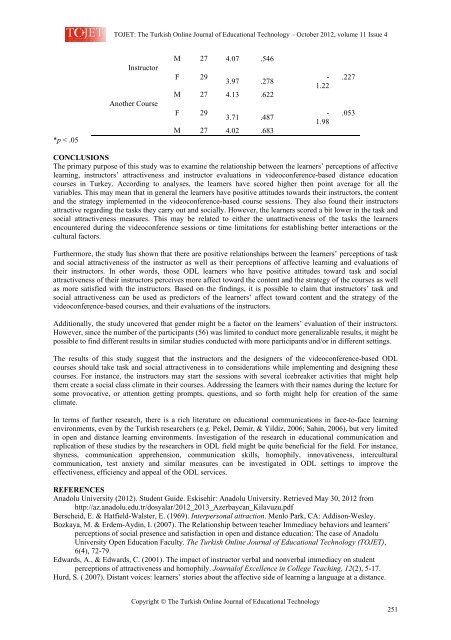october 2012 - TOJET the Turkish online journal of educational ...
october 2012 - TOJET the Turkish online journal of educational ...
october 2012 - TOJET the Turkish online journal of educational ...
Create successful ePaper yourself
Turn your PDF publications into a flip-book with our unique Google optimized e-Paper software.
*p < .05<br />
<strong>TOJET</strong>: The <strong>Turkish</strong> Online Journal <strong>of</strong> Educational Technology – October <strong>2012</strong>, volume 11 Issue 4<br />
Instructor<br />
Ano<strong>the</strong>r Course<br />
M 27 4.07 .546<br />
F 29<br />
3.97 .278<br />
M 27 4.13 .622<br />
F 29<br />
3.71 .487<br />
M 27 4.02 .683<br />
CONCLUSIONS<br />
The primary purpose <strong>of</strong> this study was to examine <strong>the</strong> relationship between <strong>the</strong> learners’ perceptions <strong>of</strong> affective<br />
learning, instructors’ attractiveness and instructor evaluations in videoconference-based distance education<br />
courses in Turkey. According to analyses, <strong>the</strong> learners have scored higher <strong>the</strong>n point average for all <strong>the</strong><br />
variables. This may mean that in general <strong>the</strong> learners have positive attitudes towards <strong>the</strong>ir instructors, <strong>the</strong> content<br />
and <strong>the</strong> strategy implemented in <strong>the</strong> videoconference-based course sessions. They also found <strong>the</strong>ir instructors<br />
attractive regarding <strong>the</strong> tasks <strong>the</strong>y carry out and socially. However, <strong>the</strong> learners scored a bit lower in <strong>the</strong> task and<br />
social attractiveness measures. This may be related to ei<strong>the</strong>r <strong>the</strong> unattractiveness <strong>of</strong> <strong>the</strong> tasks <strong>the</strong> learners<br />
encountered during <strong>the</strong> videoconference sessions or time limitations for establishing better interactions or <strong>the</strong><br />
cultural factors.<br />
Fur<strong>the</strong>rmore, <strong>the</strong> study has shown that <strong>the</strong>re are positive relationships between <strong>the</strong> learners’ perceptions <strong>of</strong> task<br />
and social attractiveness <strong>of</strong> <strong>the</strong> instructor as well as <strong>the</strong>ir perceptions <strong>of</strong> affective learning and evaluations <strong>of</strong><br />
<strong>the</strong>ir instructors. In o<strong>the</strong>r words, those ODL learners who have positive attitudes toward task and social<br />
attractiveness <strong>of</strong> <strong>the</strong>ir instructors perceives more affect toward <strong>the</strong> content and <strong>the</strong> strategy <strong>of</strong> <strong>the</strong> courses as well<br />
as more satisfied with <strong>the</strong> instructors. Based on <strong>the</strong> findings, it is possible to claim that instructors’ task and<br />
social attractiveness can be used as predictors <strong>of</strong> <strong>the</strong> learners’ affect toward content and <strong>the</strong> strategy <strong>of</strong> <strong>the</strong><br />
videoconference-based courses, and <strong>the</strong>ir evaluations <strong>of</strong> <strong>the</strong> instructors.<br />
Additionally, <strong>the</strong> study uncovered that gender might be a factor on <strong>the</strong> learners’ evaluation <strong>of</strong> <strong>the</strong>ir instructors.<br />
However, since <strong>the</strong> number <strong>of</strong> <strong>the</strong> participants (56) was limited to conduct more generalizable results, it might be<br />
possible to find different results in similar studies conducted with more participants and/or in different settings.<br />
The results <strong>of</strong> this study suggest that <strong>the</strong> instructors and <strong>the</strong> designers <strong>of</strong> <strong>the</strong> videoconference-based ODL<br />
courses should take task and social attractiveness in to considerations while implementing and designing <strong>the</strong>se<br />
courses. For instance, <strong>the</strong> instructors may start <strong>the</strong> sessions with several icebreaker activities that might help<br />
<strong>the</strong>m create a social class climate in <strong>the</strong>ir courses. Addressing <strong>the</strong> learners with <strong>the</strong>ir names during <strong>the</strong> lecture for<br />
some provocative, or attention getting prompts, questions, and so forth might help for creation <strong>of</strong> <strong>the</strong> same<br />
climate.<br />
In terms <strong>of</strong> fur<strong>the</strong>r research, <strong>the</strong>re is a rich literature on <strong>educational</strong> communications in face-to-face learning<br />
environments, even by <strong>the</strong> <strong>Turkish</strong> researchers (e.g. Pekel, Demir, & Yildiz, 2006; Sahin, 2006), but very limited<br />
in open and distance learning environments. Investigation <strong>of</strong> <strong>the</strong> research in <strong>educational</strong> communication and<br />
replication <strong>of</strong> <strong>the</strong>se studies by <strong>the</strong> researchers in ODL field might be quite beneficial for <strong>the</strong> field. For instance,<br />
shyness, communication apprehension, communication skills, homophily, innovativeness, intercultural<br />
communication, test anxiety and similar measures can be investigated in ODL settings to improve <strong>the</strong><br />
effectiveness, efficiency and appeal <strong>of</strong> <strong>the</strong> ODL services.<br />
REFERENCES<br />
Anadolu University (<strong>2012</strong>). Student Guide. Eskisehir: Anadolu University. Retrieved May 30, <strong>2012</strong> from<br />
http://az.anadolu.edu.tr/dosyalar/<strong>2012</strong>_2013_Azerbaycan_Kilavuzu.pdf<br />
Berscheid, E. & Hatfield-Walster, E. (1969). Interpersonal attraction. Menlo Park, CA: Addison-Wesley.<br />
Bozkaya, M. & Erdem-Aydin, I. (2007). The Relationship between teacher Immediacy behaviors and learners’<br />
perceptions <strong>of</strong> social presence and satisfaction in open and distance education: The case <strong>of</strong> Anadolu<br />
University Open Education Faculty. The <strong>Turkish</strong> Online Journal <strong>of</strong> Educational Technology (<strong>TOJET</strong>),<br />
6(4), 72-79.<br />
Edwards, A., & Edwards, C. (2001). The impact <strong>of</strong> instructor verbal and nonverbal immediacy on student<br />
perceptions <strong>of</strong> attractiveness and homophily. Journal<strong>of</strong> Excellence in College Teaching, 12(2), 5-17.<br />
Hurd, S. ( 2007). Distant voices: learners’ stories about <strong>the</strong> affective side <strong>of</strong> learning a language at a distance.<br />
Copyright © The <strong>Turkish</strong> Online Journal <strong>of</strong> Educational Technology<br />
-<br />
1.22<br />
-<br />
1.98<br />
.227<br />
.053<br />
251
















